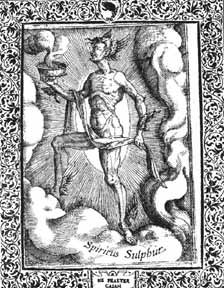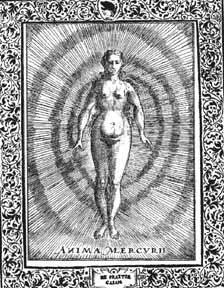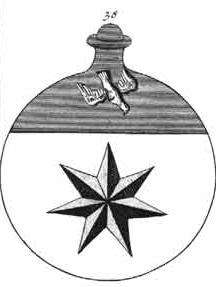3. The Ingredients
3.1 Sulfur
If you direct your heart
onto one point,
nothing will be impossible.
Buddha
Man is a thinker.
He is that what he thinks.
When he thinks fire
he is fire.
When
he thinks war,
he will create war.
Everything depends
if his
entire imagination
will be an entire sun,
that is, that he will
imagine himself completely
that what he wants.
Paracelsus

(Spiritus Sulphur, Quinta Essentia, second book)
Inside gold is the alchemical Sun. Inside
the Sun is an active substance, sulfur. Sometimes alchemists equal
sulfur with the Sun. Sulfur is the spirit of life. Sulfur is of a
twofold nature: white and red sulfur. White sulfur is the substance of
the Great Work at the phase of Whiteness, and red sulfur at the stage of
redness.
In general sulfur is the symbol for the active principle in
the Great Work.
Sulphur, the fiery spirit that vivifies
everything. The wings on his head and feet are the traditional
representations of the god Mercury.
But that (the fire) which comes
from the sun,
which fire maintains
every bodily thing
for as
far as it is natural.
Nicholas Flamel (14th-15th century)
3.2 Mercury
Every child is an artist.
The difficulty is
to remain one
when you grow up.
Picasso
Hermes is the
Primal Source.
After so many injuries
have been done to the human
race,
I flow forth,
by divine decree
and assisted by the Art,
as a healing giving medicine.
He who is able to, drink out of me.
He who wants, purify himself in me.
He who dares, jump into my
depths.
Drink, brother, and live.
Chymische Hochzeit, Christiani
Rosencreutz
No alchemical symbol is so confusing as Mercury. Here are
some explanations of this mysterious substance. As sulfur is the symbol
for the active principle, mercury is the symbol of the passive
principle. Mercury is a term used for almost everything. It is the
highest divinity, but also a devil. It is used to symbolize certain
aspects of the alchemical work, but at the same time it is them all. It
is ambiguous with many names and functions. The alchemists often speak
about mercury in the form of the god Mercury, whom we encounter in their
engravings and paintings. As the god Mercury he is often seen as having
qualities that belong both to mercury and to sulfur.

(Anima
Mercurii, Quinta Essentia, second book)
Mercury is symbolized here in
its female form of the quicksilvery soul, a reference to the soul of
Nature.
Usually mercury is used in its chemical form, quicksilver.
Symbolic of course, it indicates volatility or fluidity, by which it is
also named ‘water of life’ or ‘root humidity’.
In his aspect of fire,
Mercury is the sole fire in the entire process. He is the working force
in the Great Work. He is an ‘invisible, secretly working fire’. He is
the fire of hell, the infernal fire in the earth. Mercury is the spirit
of man that works in the lower aspects of being, and thus is looked upon
as an infernal fire.
In his air aspect, he is the spirit, the air,
the wind that is present everywhere in Nature and vivifies everything.
He is ‘the spirit of truth hidden in the earth’.
As hermaphrodite he
unifies the sexes within himself. He is both the helper and trickster,
Lucifer and Christ. When depicted as a dragon, he is flying and without
wings. He is bride and groom. It is obvious that Mercury contains and
unifies duality. He is Ouroboros, the serpent-dragon that bites in his
own tail, representing the circle and unity, eternity, where the
beginning and the end coincide. He is the alpha and omega.
He is
called the ‘prima materia’, the chaos, the rough stone at the beginning
of the Great Work. As Saturn he initiates putrefaction, but also gives
immortality. At the same time he is the goal of the Great Work, the
philosopher’s stone, the elixir of life, the philosophical gold. Mercury
is the process of transmutation.
In alchemical images Mercury is
depicted both as a young man and an old man. As an old man he is usually
in the form of Saturn, the common man, fixed in matter with his habits,
prejudices, and other material chains. As a young boy, he comes forth
from the ‘coniunctio’, the joining of the King and Queen, representing
rebirth, and eternal youth.
Mercury is also called ‘quadratus’
because he contains the four elements, thus he is the quintessence.
Another name for him is ‘azoth’ a word formed from the Latin letters A
and Z, the Greek words Alpha and Omega, and the Hebrew words Aleph and
Thau, all meaning the beginning and the end.
Here is a text from the
Aurelia Occulta from the Theatrum Chemicum (1613), in which Mercury is
talking about himself:
I am the poison-dripping dragon,
who is
everywhere and can be cheaply had.
That upon which I rest, and that
which rest upon me,
will be found within me by those who pursue
their investigations in accordance with the rules of the Art.
My
water and fire destroy and put together;
from my body you may extract
the green lion and the red.
But if you do not have exact knowledge of
me,
you will destroy your five senses with my fire.
By the
philosophers I am named Mercurius.
My spouse is the gold;
I am the
old dragon found everywhere on the globe of the earth,
father and
mother, young and old, very strong and very weak,
death and
resurrection, visible and invisible, hard and soft;
I descend into
the Earth and ascend into the Heavens,
I am the highest and the
lowest, the lightest and the heaviest.
I am dark and light.
Often
the order of nature is reversed in me.
I am known yet do not exist at
all.
I am the carbuncle of the sun, the most noble purified earth,
through which you may change copper, iron, tin and lead into gold.
A
waxing poison comes from my nose,
having brought to death many
people.
Therefore, with the art,
you have to separate the course
from the fine,
if you don’t wan to delight in poverty.
I give you
the power
of the male and the female,
even that of heaven and
earth.
With bravery and broadness of understanding,
the mysteries
of my art are to be done,
if you want to conquer me with the power of
the fire.
From which many have suffered in their potential and work.
I am the egg of nature,
that only the wise man knows,
who by piety
and modesty
let the microcosm arise out of me,
what is destined to
people by the most high God,
but what is given only to a few,
while most long for it in vain:
that they do well to those in poverty
from my treasury
and that their soul will not cling to the transitory
gold.
I am called Mercurius by the Philosphers;
my mate is the
philosophical gold;
I am the old dragon, present everywhere on earth,
father and mother, young man and old man,
very powerful and very
weak,
death and rebirth, hard and soft;
I descend into the earth
and ascend into heaven’
I am the highest and the lowest,
the
heaviest and the lightest;
often the order of nature in color, number
, weight and measure
is being reversed in me,
I contain the light
of nature (lumen naturale);
I am the dark and the light,
I come
forth from heaven and earth;
I am known but do not exist;
all
colors radiate in me
and all metals by the sun’s rays.
I am the
solar carbuncle,
the most refined, glorified earth,
by which you
can change
copper, iron, tin and lead
into gold.
3.3 Salt
He who wants to get insight and enlightenment in all truth,
think of God’s birth in himself,
in the depth of his soul.
As soon
as he will open himself for that,
all energies of the soul come to
life,
and in one instant
he receives more wisdom
than anybody
can teach him.
Meister Eckehart

Salt is the third element in the
trinity of the alchemical substances in the Great Work. As mercury is
the water aspect, sulfur is the fiery aspect, so is salt the form aspect
(salt is a crystalline form, or crystallized energy). So it is also a
name for the ‘prima materia’, for the stone of the philosophers. The
alchemists say that in its lower aspect salt is ‘bitter’. Here salt is
symbol for knowledge and wisdom. Self-knowledge is bitter, painful.
Sometimes they speak of the bitter ‘sea water’. As water or the sea
stands for the soul, it is a reference to the same self-knowledge.
Salt is also seen as a symbol for the second phase of the Great
Work, albedo, or whiteness, because here light breaks through, and thus
also wisdom. Christ is called ‘Sal sapientiae’, the Salt of Wisdom’.
In the beginning of the Great Work, the salt is called impure. Here it
equals the earth, the body, our every day consciousness or being. The
impure salt has to be dissolved (‘solutio’) into the divine water
(quicksilver, or ‘prima materia’), by which it is purified. In albedo
salt arises as a pure form and fixated, that is crystallized into a pure
salt.
As symbol for wisdom, salt is the breath of the divine energy.
This wisdom vivifies the invisible fire that energizes entire Nature.
This fire controls life, movement, energy, the heavens, the planets.
Paracelsus called this fire ‘the light of Nature’ a reference to the
‘anima mundi', the soul of the world.